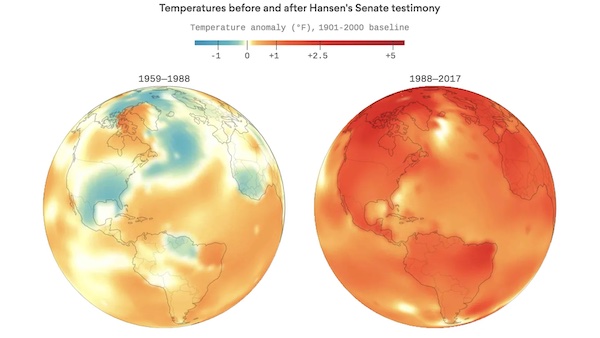35 Years Of Climate Change Predictions
35 years since the first climate change predictions – were they alarmist?
 Since the 19th century, researchers have been warning about the global repercussions of human actions. James Hansen’s research group at was the first to confirm that the increase in greenhouse gas emissions was altering the planet’s climate.
Since the 19th century, researchers have been warning about the global repercussions of human actions. James Hansen’s research group at was the first to confirm that the increase in greenhouse gas emissions was altering the planet’s climate.
In their scientific article, published in the Journal of Geophysical Research, they outlined how they developed the first predictive climate model that, taking into account greenhouse gas emissions, warned about the climate change that was already underway and the potential future scenarios.
At the time, this prediction was considered catastrophic and faced criticism from various sectors, including the oil industry, one of the largest contributors to greenhouse gasses emissions worldwide.
Were the early climate predictions really that inaccurate?
Critics of anthropogenic climate change often claim that climate predictions are consistently wrong and are frequently updated to downplay the issue. However, this perspective is misleading. 
Climate predictions are indeed updated and refined as new data becomes available, reducing inherent uncertainties in modelling a complex, chaotic system like the climate. However, this doesn’t mean earlier predictions were wrong. They were made with less computing power, lower-quality data, and greater uncertainty about future emissions.
The key point is that climate responds differently to various emission scenarios, and predicting human behaviour regarding emissions is just as critical as forecasting climate responses.
In 1988, Hansen’s team analysed global average temperature data from 1958 to 1987 and developed three prediction scenarios—A, B, and C—projecting climate trends up to 2060.
Scenario A assumed a continuous increase in greenhouse gas emissions, extending the growth pattern seen in the 1970s and 1980s indefinitely, with an annual increase of 1.5%. This scenario predicted rapid and substantial climate change, with a temperature increase of 0.9°C above the 1951-1980 average by 2000, 1.5°C by 2020, 3°C by 2040, and up to 4°C by 2060.
 Scenario B anticipated a more gradual stabilization in emissions, resulting in a slower but still consistent temperature rise. It predicted a 0.5°C temperature increase by 2000 and 1.2°C by 2020. Predictions for scenario B extended until 2028, reaching nearly 1.4°C of temperature increase, as uncertainties grew significantly beyond that year.
Scenario B anticipated a more gradual stabilization in emissions, resulting in a slower but still consistent temperature rise. It predicted a 0.5°C temperature increase by 2000 and 1.2°C by 2020. Predictions for scenario B extended until 2028, reaching nearly 1.4°C of temperature increase, as uncertainties grew significantly beyond that year.
Scenario C resembled scenario B initially but assumed a drastic reduction in emissions between 1990 and 2000, eventually stabilizing around 2010 and fluctuating between 0.6°C and 0.8°C of temperature increase.
You can explore climate predictions for these scenarios for your location using the Teaching the Future Data Dashboard.
Reviewing Hansen’s Model
 To determine whether Hansen’s initial model was accurate or not, it’s insufficient to examine the predictions in isolation, as the three scenarios presented diverse outcomes. The key is to assess whether, based on actual greenhouse gas emissions in recent decades, the consequences align with Hansen’s predictions rather than deviating in unforeseen ways.
To determine whether Hansen’s initial model was accurate or not, it’s insufficient to examine the predictions in isolation, as the three scenarios presented diverse outcomes. The key is to assess whether, based on actual greenhouse gas emissions in recent decades, the consequences align with Hansen’s predictions rather than deviating in unforeseen ways.
In 2020, researcher Zeke Hausfather from the University of California, Berkeley, along with collaborators, revaluated Hansen’s model. First, they analysed real observed data and they found that it closely resembled the predictions of scenario B, although with some irregularities. Recognizing variable emissions over the past three decades, researchers incorporated actual emissions data into Hansen’s climate model, resulting in remarkably accurate predictions. 
Similar situations apply to subsequent models, not because they fail but because climate predictions depend on unpredictable global emissions. This leads to various scenarios, from extreme to intermediate, reflecting uncertain human behaviour. When emissions deviate from assumptions, climate outcomes also change, not due to model flaws but unpredictable human actions. Regular model updates use better data and computing power to adapt to changing circumstances, eliminating unfulfilled scenarios and projecting new ones.






